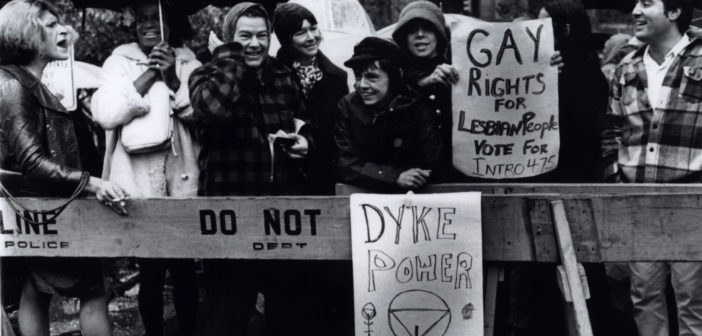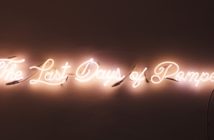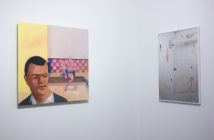HARD: Subversive Representation, a group show on view at UMass Boston’s University Hall Gallery, mounts a bold critique of gendered systems of representation. Organized by Gallery Curator Sam Toabe, HARD is the companion to SOFT, a project at Sübsamsøn in 2015 that interrogated the distinction of fiber art as feminine by showing a group of men working with fibrous materials. Extending the straightforward curatorial thesis of SOFT, the artists in HARD are all women, although their work does not share the formal or material connections of SOFT. Instead, the artists in HARD all use women as the subjects and objects of their work.
At this point, shows about women representing women typify an established feminist approach to exhibition making, and the limitations of such exhibitions lurk around the edges of HARD. Expansive surveys of women artists have been criticized because they conflate and then flatten the diverse experiences of women to conform to mainstream feminist aesthetic and political impulses. The recent We Wanted a Revolution: Black Radical Women, 1965–85 and Radical Women: Latin American Art, 1960-1985 have just begun to address what it really means to be a gendered and raced and classed body in the world. Though not explicitly examining the genus of exhibition and histories of feminist thought from which it derives, HARD revisits a curatorial model proposed in far-ranging, comprehensive exhibitions like WHACK! Art and the Feminist Revolution and Global Feminisms. Information and reflection, however, synthesize the otherwise sprawling thematic premise of women artists representing women. In addition to overturning assumptions about what women look like as subjects and objects of art, the artists in HARD scrutinize the ideological conditions underlying the production, content, and consumption of art about women. In this way, HARD is worthy of close study precisely because it makes room for political issues that both impact and transcend representations of women.
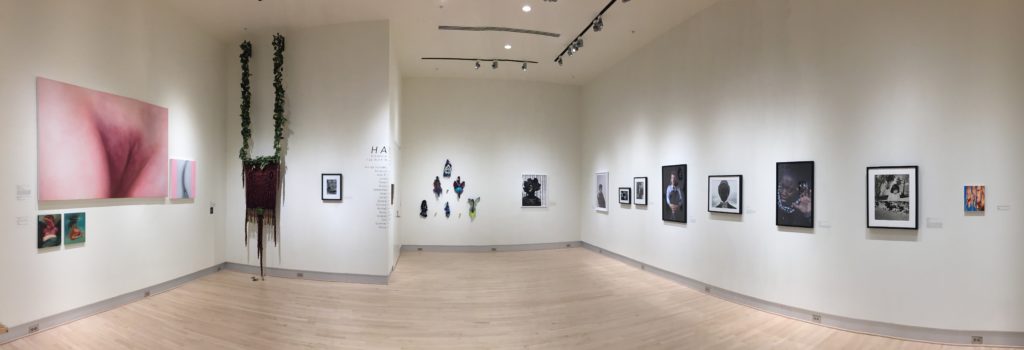
Installation view of HARD: Subversive Representation. Courtesy of University Hall Gallery, UMass Boston.
Which is why the minimal interpretive text or background accompanying the presentation is so perplexing. HARD lets art speak for itself, a move which either augments or complicates the meaning of the work. Ariel Basson Freiberg’s equivocal figural paintings are at once concerned with the methods of painting (how one applies pigment to canvas) and with the state of figuration (how figuration can continue to be innovative despite the oversaturated history of people painting people). Freiberg pushes representation to the point of disintegration in the collage-like Untitled (2013), and experiments with additive marks that oscillate between obliteration and enhancement in Out Running the Moon (2017), Body Jam (2017), and Can You Hear Me? (2017). At times reduced to nothing but an arrangement of limbs, but at others depicting almost complete subjects, Freiberg’s paintings ask us to consider the possibilities of what painted women can look like at the conceptual and material limits of the painted landscape. In contrast to Freiberg, Betty Tompkins approaches painting through the lens of explicit visual imagery which objectifies women’s bodies, a historically-laden artistic strategy that demands a frame of reference. Tompkins sources her imagery for Masturbation Painting #12 (2016) and Ersatz Cunt Painting #1 (2016) from pornographic stills which she then manipulates with acrylic. The alarmingly-proportioned close-ups of the action of masturbation and a vulva address the split between the experience of being a body and the experience of objectifying someone else’s body. By themselves, women’s bodies are just fleshy vessels through which to navigate being alive. In the context of pornography and even art, women’s bodies become repositories for the observers’ egos, desires, fantasies, and fears. By magnifying those actions and parts of the body most altered by the observer’s projections, does Tompkins reproduce or dismantle spaces of sexual objectification? The artist’s commitments and creative outcomes remain ambiguous, an uncomfortable conclusion for a group show in which not every woman represented may even possess the body parts illustrated by Tompkins. Artist’s intentions aside, without information, there is simply no way to grasp the historical significance of works like Berenice Abbott’s 1923 photographic portrait of Jane Heap, the publisher and editor of the remarkable modernist literary journal The Little Review.
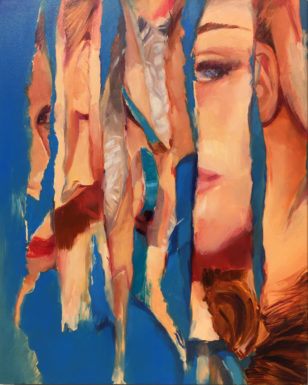
Ariel Basson Freiberg. Untitled, 2013. Oil on panel. 10 x 8 inches, courtesy of the artist & Abigail Ogilvy Gallery
For each work that asks for more context in order to be understood, there exists another work with messaging more immediately perceived, particularly by those who see facets of themselves within the represented women. Much of HARD uses a terminology of femininity deriving from the experiences of lived bodies who complicate the socially conditioned codes of gender. For example, in the multi-channel video installation Bodybuilder Vignettes (2016), Rachel Rampleman describes women as an unfixed category. The recordings show ten women bodybuilders contorting their hyper-muscular bodies into impossible poses for a competition. Given the thesis of HARD, the vignettes remark on the malleability of gender. The enhanced bodybuilder physique displays attributes defined (at least socially) as feminine and masculine; when such characteristics can coexist within a person, categories such as woman are bound to expand.
The artists in HARD work in time periods spanning the modern to the contemporary. Unhindered by conceptually-restrictive thematic sections, the potential for furtive dialogues between artworks across time constitutes one of the strengths of the exhibition. For example, Abbot’s photograph of Jane Heap takes part in an exchange with that of Ianna Book’s Trans and the notion of Risk: Post Surgery: #3 (2015/2016). Like Heap, the subject gazes directly at the camera and wears a dress shirt and tie. Rather than projecting self-assurance, the woman in Book’s photograph conveys vulnerability; she is seated in a protective posture with knees drawn to her chest, and her face displays still-healing postoperative surgical scars and bandages. Nearby Book, Diana Davies photograph Demonstration at City Hall, New York City, in support of gay rights bill “Intro 475” (1973) provides historical context for the physical transformation undergone by Book’s subject. Davies photographed icons of the Stonewall Riots (June 28, 1969 – July 1, 1969) and political activists Marsha P. Johnson and Silvia Rivera protesting at a gay rights rally. Vocal in their lifetimes about the uneasiness of navigating public sites as transgender women (or as they termed themselves, drag queens), Johnson and Rivera continue to remind us of the intersectionality of the various struggles for human and civil rights. HARD offers a historic example of the discrimination and stigmatization experienced by transgender women in the nearby photograph, Joan E. Biren (AKA JEB)’s Amie and J. Michigan Womyn’s Music Festival August 1983 (1983). JEB documents women attending the annual feminist music festival which controversially only embraced “womyn-born-womyn,” i.e., cisgender women. In one of her two contributions to the show, Zanele Muholi makes palpable the precariousness of being transgender in public spaces in South Africa. Yaya Mavundla II, Parktown, Johannesburg (2017), from the series Brave Beauties series (2014 to the present), observes the self-fashioning used by its subject to signal femininity. Glamorous, well-coiffed, and wrapped in a textured hair coat, Yaya Mavundla engages with the politics of ‘passing’; a term that refers to a transgender person’s capacity to ‘pass’ as cisgender (often by conforming to limited modes of dress) or else risk harassment and physical violence.
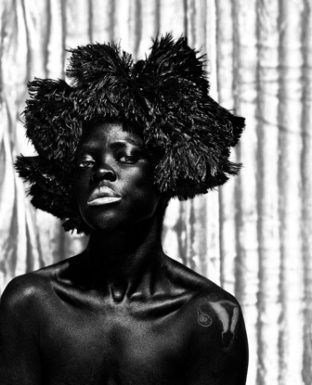
Zanele Muholi. Faniswa, Seapoint, Cape Town, 2016. Archival Pigment Print, 31 1⁄2 x 25 1⁄2 inches. Courtesy of the Yancey Richardson Gallery, New York.
HARD makes room for issues related to race, an intersectional approach to the topic of women and representation that lends depth to the exhibition. Zanele Muholi’s Faniswa, Seapoint, Cape Town (2016) derives from a series of self-portraits titled Somnyama Ngonyama or Hail the Dark Lioness (2015 to the present). Manipulating props like hairpieces and using high-contrast lighting, Muholi exaggerates her ‘blackness’ in order to make palpable the racist characterizations ascribed to black women. Here, it is vital to note that Muholi approaches race and racism in a way that is specific to her subject position as a black South African. The other photographs of black women in the exhibition, though hung close to Faniswa, represent experiences that may or may not relate to Muholi’s. At least somewhat similar in terms of formal properties and content, Del LaGrace Volcano’s Moj Minstrel Tears, Antarctic Peninsula (2005) and Christie Neptune’s What Was Taken 02 (2015) portray black women crying. In capturing this intimate yet universal emotion, both photographs encourage empathy for the individuals represented; a strategy often used to deconstruct the stereotypes which dehumanize historically marginalized groups.
Artists associated with the Boston-area manufacture the most captivating moments in HARD by engaging with the tradition of feminist intervention into history and its related academic disciplines. Unlike the explicitly body-oriented work elsewhere in the show, these artists use innovative visual languages that combine solid research with conceptual art, photography, installation, sculpture, performance, and mark-making. Samantha Fields’s Eve After Fragonard (2017) alludes to the lives of women obscured in written history. Fields collapses the identities of Eve, the figure which the Hebrew Bible identifies as the first woman, with the subject of Jean-Honoré Fragonard’s painting The Swing (1767), the mistress of the man who commissioned the painting. Rather than constructing a figurative body, Fields portrays the subject in abstract terms which merely suggest a body, an apt metaphor for how history takes ownership of and then alters women’s stories. In the installation, two garlands of artificial foliage hang from the ceiling and support a machine-made tapestry bearing a pattern which mimics the forms of body parts, most notably breasts. Hundreds of hand-strung beads reach from the bottom of the tapestry to the floor, punctuated by a small patch of foliage positioned over what would be the vulva of the theoretical figure. Like Eve After Fragonard, Anabel Vázquez-Rodríguez’s photographic combine displays a subject bifurcated by time and also psychology. Juxtaposing two photographs from the artist’s personal archive (the top an image of the artist as a child posing in front of a tropical poster, the bottom an image of a beach in Puerto Rico captured from the perspective of a plane) RETROPICAL (2002) mimics the apparatus of the mind, which amalgamates disparate moments into a singular narrative that excises subtlety, nuance, and even truth. The mind mimicked by Vázquez-Rodríguez is located outside of the self—a collective mind that fetishizes women identified as ‘exotic’ or ‘tropical’ due to their race and/or ethnic group. Summer Wheat's (based in Brooklyn) bizarre and visionary Infinity Dolls (2017) imagines the primordial form of women. A low-to-the-ground black pedestal, covered by a cutout approximating the shape of a woman, supports a circular plinth encrusted in gritty black sand. Metallic-colored lumpen figurines are positioned on its surface in an exuberant starburst shape. Possessing only hints of leg, arm, breast, the figurines occupy the liminal space between formlessness and order, capturing the galactic event when women came into being.
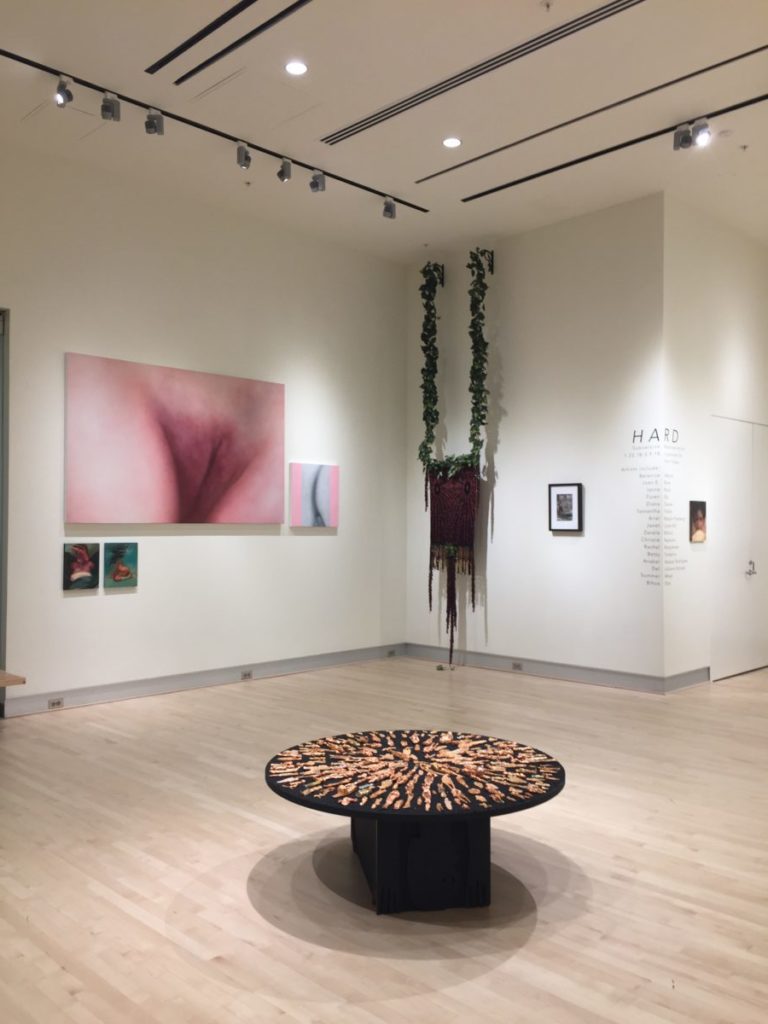
Installation view of HARD: Subversive Representation. Courtesy of University Hall Gallery, UMass Boston.
Janet Loren Hill’s Common Scolds series also employs an intertemporal methodology through which the artist compares the historical and present conditions of women. The series derives its mask-like forms from a sixteenth-century European device known as a scold’s bridle. Made of metal and often incorporating jagged tongue depressors which lacerated the mouth if the wearer spoke, these literal muzzles were used to punish women guilty of gossip or witchcraft. Hill appropriates the form of these torture instruments to create vibrant sculptures made of colorful crochet and sewn fabrics. Though visually exuberant, the Common Scolds series maintains a stance of criticality towards the treatment of women, both in the past and in the present. From their sub-titles (which read, among others, Maybe it would have been a work meeting, or maybe he was going to try and fuck me and When I do his job for him, I get a, ‘good girl’) to the cast iron nails holding the sculptures on the wall to the rape whistles which adorn some of the sculptures, the Common Scolds series exhibits a feminist stance towards the present condition of women, understanding it to be the result of a long-enduring system of oppression. Furen Dai & Bihua Zhan’s use primary source documentation of this system in Message through Generations (2015-2018). In an action accomplished before the opening of the exhibition, Furen and her mother Bihua stood on opposite sides of one of the gallery’s windows and proceeded to read and write on the window passages from the Chinese book Commandments for Women. Though written circa 100 CE, some of the ‘rules’ outlined in Commandments continue to determine aspects of women’s lives, and Furen and Bihua’s actions distill the mechanics of how older generations transmit behavioral codes to younger generations.
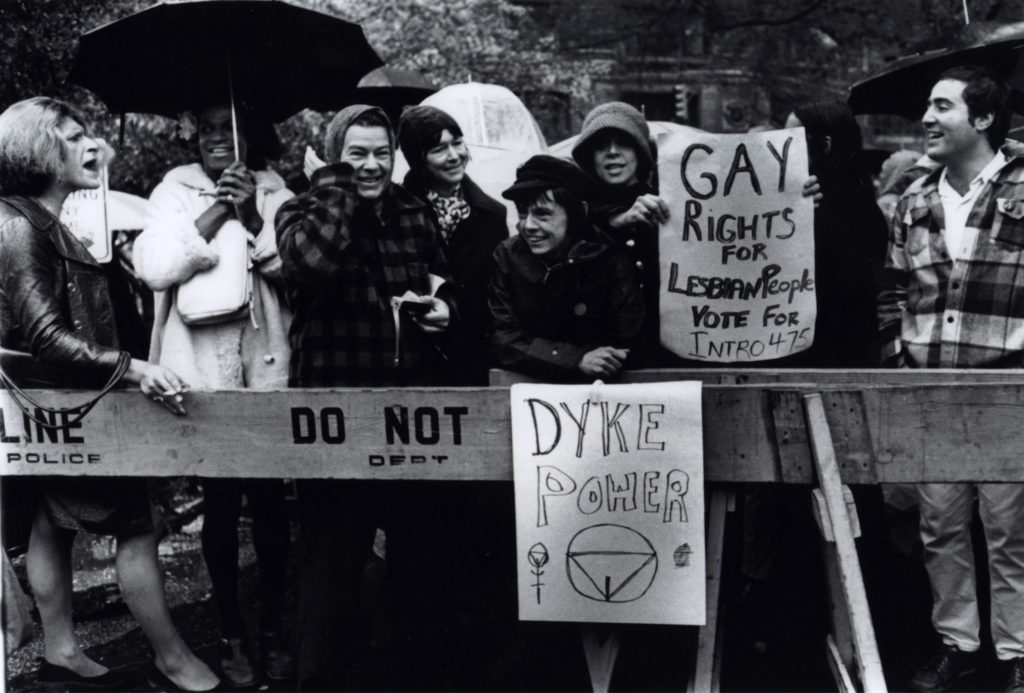
Diana Davies, Demonstration at City Hall, New York City, in support of gay right bill “Intro 475” 1973, digital photographic print, 11 x 14 inches. Courtesy of the Leslie Lohman Museum of Gay and Lesbian Art.
To deeply consider the artists in HARD: Subversive Representation is to realize that making and viewing art can still be profoundly political gestures. Art magnifies, in visually immediate terms, the relationships and values composing the social landscape. In this way, the subtitle “Subversive Representation” accurately captures the threat posed by the artists in the show. These artists are decidedly dangerous because they have the power to expose the shortcomings and failings of the structures under and for which they labor. But, subversive representations of women in and of themselves do not necessarily inspire paradigm shifts—that can only be accomplished by those interpreting and looking at such work. Though at times difficult to suss out how each artist is subversive and to what ends, HARD is well worth the effort.
HARD: Subversive Representation is on view at the University Hall Gallery at the University of Massachusetts, Boston and has extended its run through April 20, 2018.

